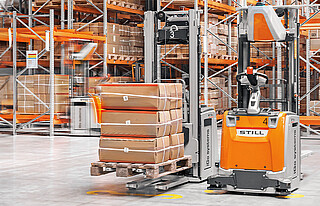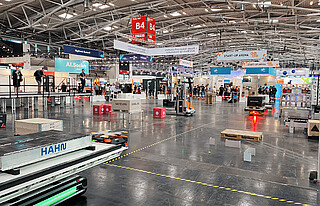The automation interface: VDA 5050
There is still no universal standard in the field of automation and this makes networking, which will become even more important in the future, more difficult. That is exactly what the VDA 5050 interface aims to solve. Here is why such open interfaces are so important for the future of intralogistics.

Intralogistics depends on standards. From Euro pallets to barcodes, without standards many processes would not work as smoothly, would not interlock as seamlessly. Once these standards are in place, it makes no difference which manufacturer, which start-up or which warehouse manager is currently transporting, lifting or picking goods. A win-win situation for everyone. But what happens when it comes to automation? Up to now, many manufacturers have been proud (and rightly so) of their ingenious individual solutions, their tailor-made, well thought-out hardware and software solutions. As a result, it can be very time-consuming to install automated solutions on site and get them to communicate with all the other relevant devices and components. This is where VDA 5050 comes in: an open interface, in this case between automated guided vehicle systems (AGVs) and the corresponding control software, the so-called fleet controller.
Open systems are the future of successful solutions
"The future of successful logistics solutions lies in opening up systems," says Florian Heydenreich, Executive Vice President Sales & Service STILL EMEA. This is the only way to optimise all processes along the entire value chain. Heydenreich knows that the topic of automation is literally on everyone's lips: customer interest is constantly increasing. Numerous industries and companies everywhere are looking at the issue - and expecting solutions that work. The pandemic and the shortage of skilled workers have added to the momentum. “Operators who are automating different processes and work steps are not necessarily able to commit to just one manufacturer. They need a simple option that allows different automation solutions to communicate with each other," says Heydenreich. But an open interface is also an advantage for manufacturers: STILL can use it to integrate more easily into existing automation systems, says Heydenreich: "All new trucks that customers buy from STILL are prepared for VDA 5050".
This also makes sense because more and more customers are already asking for VDA 5050 in their invitations to tender. Heydenreich is increasingly aware of this, especially in process-focussed industries such as the automotive industry. One thing is certain: there is still a great need to educate many users about automation and, in particular, autonomous vehicles - both technologically and operationally. "But intralogistics is also making progress here," Heydenreich emphasises, "and we at STILL take the responsibility and the opportunity to support our customers with our automation expertise very seriously".

Driverless transport systems need to be networked
Because this is the technology of the future: optimised process chains, flexible production lines, intelligent warehouses - all these things are inevitably demanded by end consumers and, by extension, by companies. Products such as customised trainers with engraved names would be unthinkable without automated technology. And it is this type of product that will play an even bigger role in the future than it does today. Consumers want personalised offers - not always, but increasingly. There is also a general expectation for faster production and delivery. Automation and autonomous devices are also key. "In the long term, there is no conceivable scenario other than open systems and interoperability," says Heydenreich. Interoperability means the ability of different systems to work together seamlessly - this is what makes AGVs and other automated and autonomous solutions efficient, for example by avoiding proprietary interfaces that are costly and prone to error.

Warehouse operators and logistics managers do not want their forklift trucks to move in a different IT system than the heavy lorry. Transport logistics and intralogistics are interlinked and can only be realised as a single unit across different locations, systems and devices. A driverless transport system does not operate in a vacuum; it must be connected to the relevant IT system for stock levels or bookings, for example.
And customers do not want to spend unnecessarily more money on customisation and configuration than the automation solution itself has already cost. With the VDA 5050 standard, intralogistics is once again demonstrating its role as a pioneer and thought leader for other sectors.
VDA 5050 as the relevant interface
This is underlined by the fact that "logistics projects are already largely IT projects," says Heydenreich. Hardly any project can do without software: "The software maps the process, the products are then intelligent tools". In the long term, this will also change the companies involved: More IT staff will be needed and internal billing processes, for example, will have to change. "This makes it all the more important to us that our solutions are not huge IT projects, but can be integrated into existing systems as easily as possible," says Heydenreich. Simplification is important and in the interest of the customer.
However, VDA 5050 is not the only open-source standard currently being developed. Other players have also recognised the importance of the issue, including technology giants such as Google and Microsoft. "Who will come out on top will depend on a number of different and complex factors," admits Heydenreich. It is also conceivable that there will be different standards in the end. However, VDA 5050 is currently the relevant interface, especially in Germany: "At the moment, we do not see any other standard that is comparable for us, our vehicles and our systems," concludes Heydenreich. Nevertheless, it is important to observe the market and the subject – and STILL has already demonstrated the necessary expertise and competence in numerous automation projects to do so.
Want to know more about the AGV Mesh-Up? Watch the "AGV Mesh-Up 2023 Review" video now.
Comments
No comments
Subscribe to our blog!
As soon as a new article is published, we will notify you! You can unsubscribe at anytime.





Leave a comment